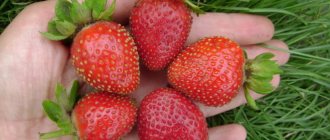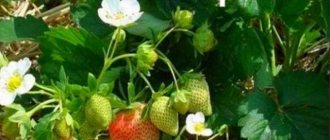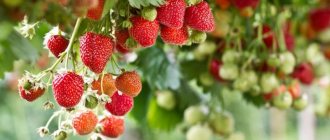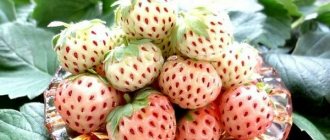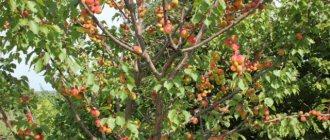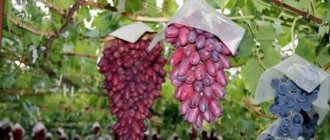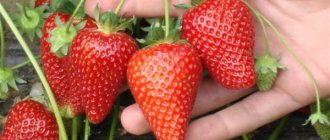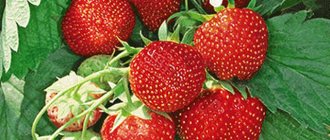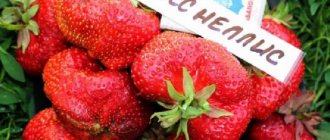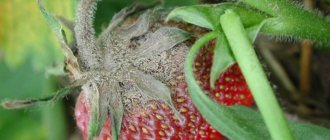Description of the strawberry variety Symphony, the photos and reviews of which are more than attractive, are of great interest not only for amateur gardeners, but also for farms. This is an unpretentious variety of foreign selection, adapted for cultivation in Russia in open ground and greenhouses. The key characteristics of the Symphony strawberry are an extended fruiting period, good keeping quality of the berries and excellent transportability, which makes this variety suitable for growing for sale.
Description of the strawberry variety Symphony
Strawberry bushes of the Symphony variety are distinguished by their dense foliage and rather large size. The root system of plants is branched, well developed - the roots go into the ground to a depth of 40 cm.
The leaf blade of the variety has a dark green color and is slightly harsh to the touch. The veins on the back of the leaf can be easily felt. The length of the shoots of strawberries of this variety averages from 30 to 40 cm. The horns of the peduncles are pubescent, short, but there are many of them. Strawberry Symphony blooms profusely.
According to the description of the Symphony variety of strawberries, the plant produces fairly large berries, which is confirmed in the photo and in the reviews of gardeners. Their weight varies from 35 to 40 g. The berries are cone-shaped, bright red in color and with shiny skin. The pulp is dense and fleshy, juicy. The aroma of berries is often compared to the smell of raspberries. The seeds of the variety are small, yellowish. They are deepened into the pulp of the berries.
The scope of application of strawberries of the Symphony variety is universal, although it was bred primarily as a dessert variety intended for fresh consumption. It sells well and is often used for winter preparations in the form of preserves and jams. In addition, strawberries can be frozen without losing their beneficial qualities.
Attention! The Symphony variety is not remontant. It blooms only once during the growing season.
This variety was bred for cultivation in unfavorable climatic conditions, so the plantings equally well tolerate both prolonged drought and low temperatures. The Symphony variety is considered one of the most stable and unpretentious - it is planted even in the Urals and Siberia, where many other species freeze out in winter.
The reviews especially emphasize the excellent immunity of the variety to most diseases that usually affect strawberry bushes. In particular, Symphony strawberries are resistant to verticillium and gray rot.
Strawberry Symphony
There should be a lot of good varieties - replenish your piggy bank with another recipe worthy of close attention. A sweet symphony of taste and an ode to productivity, a rhapsody of abundance and an ode to strawberry fields - the strawberry Symphony and everything connected with it.
Description, yield and ripening time, abstract morphological characteristics, growing tips.
The photo shows the Symphony strawberry harvest.
Medium-late ripening, extended harvest period. Despite the beginning of the description that does not inspire optimism, thanks to its high-profile pedigree it has luxurious characteristics: a bright dessert taste of large berries, yield, keeping quality and transportability.
Recommended for cultivation as an industrial variety with subsequent sale in retail chains, for the fresh market, promising in amateur gardening, large and small agribusiness.
Description of the strawberry variety Symphony
- Ripening time is a week later than Elsanta, at almost the same time as Zenga Zengana.
- The bush is powerful, well leafed. The leaf blades are hard and dark.
- Peduncles are powerful, medium-pubescent, multi-flowered.
- The berry is medium and large, with bright red shiny skin and scarlet, uniformly colored juicy pulp. Sweet, juicy, meaty - the main taste is a real symphony of taste. The shape of the fruit is conical, regular, and the overall mass is homogeneous.
- The seeds are yellow, small, slightly recessed. A characteristic feature is that with incomplete ripening, the tip is pale, slightly greenish (white). The tear is easy, the stalk is easily separated.
- The fruits are storable and suitable for transportation.
- It is winter hardy and not afraid of heat and drought.
- Resistant to fungal spots, verticillium, gray rot.
Growing Symphony
What is important to know about growing strawberries of the Symphony variety, what is important not to miss in care - briefly, succinctly, to the point
Berries of the strawberry variety Symphony.
It is worth paying attention to the distance when planting: saving space will not lead to increased yield. When planting on ridges using the two- or four-line method, when thickened, a solid wall is formed - do not approach, do not approach
But this is not the main thing: by reducing planting density, we reduce the feeding area.
In the first year after planting, it is better to pick off the flowers, preventing fruit from setting. This way we will direct energy to the formation of a powerful root system, the above-ground part. And then the berries.
About fertilizing: mentioning the unpretentiousness of the variety does not mean that fertilizing is not needed. On the contrary, practice shows: the higher the yield declared by the patent holder, the more you need to invest in strawberries for its full return. Symphony is not a particularly large-fruited plant that requires repeated feedings, but it cannot be called ascetic either.
In the spring, it is rational to add organic matter - mullein in a ratio of 1:10, bird droppings 1:15, a nitrogen-mineral complex, including essential potassium, nitrogen, phosphorus and trace elements. Among the preparations – Master, Kemira or those fertilizers that you are used to.
After harvesting, care continues; if you decide to mow, you should not delay until late autumn: strawberries need time to develop and a certain period of rest. After mowing, organic matter and a mineral complex are added.
Despite the declared winter hardiness, all European varieties behave differently in the continental climate of Russia and Ukraine. Thus, varieties that are not covered in such close Poland in Ukraine require shelter, and this applies to all berry crops.
Pros and cons of the Symphony variety
The positive aspects of Symphony strawberries include the following qualities:
- large berries;
- uniform ripening of fruits;
- maintaining fresh appearance and taste when harvesting is delayed for several days;
- excellent dessert taste;
- versatility of the scope of application of fruits;
- attractive appearance;
- keeping quality;
- good transportability;
- high productivity;
- relative ease of care;
- resistance to unfavorable climatic conditions - the variety safely survives harsh winters and dry periods;
- resistance to most diseases;
- adaptability for growing in short-day conditions, thanks to which strawberries can be planted in the Northern regions.
There are no pronounced shortcomings in the Symphony variety of strawberries, however, some gardeners in reviews note the lack of remontant qualities as such.
Features of bush strawberries
Strawberry varietal forms that are well known to summer residents grow mustaches constantly. To increase productivity, gardeners remove shoots with rosettes, and to obtain planting material, they specially plant plants in separate beds.
Bush strawberries have a number of differences:
- small size bushes;
- absence of whiskers (or very few of them on the bush).
For such compact plants, it is not necessary to maintain long distances in rows, and care is simplified. They are great for small gardens, plantings near trees or shrubs, and a large number of varieties and hybrids make it possible to obtain a harvest all season long.
Among the bush forms are strawberries with long and neutral daylight hours. The berries ripen several times during the summer, and some varieties bear fruit almost continuously. They note the excellent taste of strawberries, while the berries are suitable for processing and tasty fresh.
Breeders have developed large- and small-fruited, early and mid-ripening varieties
When choosing, be sure to pay attention to the variety’s resistance to sub-zero temperatures and take into account recommendations for rejuvenation
Planting and caring for Symphony strawberries
Symphony strawberries are planted at different times of the year - this is done both in autumn and spring, and even in the summer months. In autumn, planting is carried out no later than mid-September, otherwise the bushes will not have time to take root in a permanent place before the onset of cold weather.
In summer, strawberries are planted only if the planting material is packaged in special containers. The optimal planting time is the last days of July - mid-August.
In the spring, strawberries are planted after the threat of return frosts has passed. It is necessary to wait until the soil warms up, which usually occurs at the end of March - beginning of April.
Advice! Planting strawberries of the Symphony variety in the fall has the advantage of being able to collect berries the following year.
For good fruiting, it is necessary to prepare the area in advance before placing the beds.
Selection and preparation of a landing site
Open areas that receive sufficient light are best suited for growing strawberries. It is recommended to provide protection from strong winds, which negatively affect the development of plants.
The variety does not have any special requirements for soil composition, but Symphony strawberries bear fruit best in areas with forest soil and black soil. On heavy soils with a high clay content, the growth and flowering of strawberries is inhibited. Preparing the site for future beds involves digging it up with a spade, and it is recommended to fertilize the soil.
The following mixture is suitable as a fertilizer:
- 1 bucket of compost (can be replaced with humus);
- 25-30 g of potassium sulfate;
- 150 g superphosphate.
This amount is enough for 1 m2. Also, the Symphony variety responds well to fertilizing the soil with a mixture of dolomite flour and ash, which is applied to the soil in a 1:1 ratio. 1 tbsp is consumed per 1 m2. substances.
Important! The preparation of the site for planting strawberries is carried out at least 5-6 months before placing the seedlings.
Preparation of planting material
Preparation of planting material involves its careful inspection. Seedlings must have a developed root system (recommended root length is 8 cm), thick and strong shoots, as well as from 3 to 7 full leaves. They should be free of stains, plaque and other damage. The leaf blade of a healthy seedling is smooth, without wrinkles. Strawberry roots should not be dark - this is the first sign of a disease in the plant’s root system.
In order for strawberries to take root better in a new place, it is recommended to dip the roots of the seedlings for 25-30 minutes in a growth stimulator. To enhance the effect, add 2-3 crystals of copper sulfate to the water. Such treatment accelerates the rooting process of plants and stimulates their growth.
Landing rules
The Symphony variety is planted according to the following scheme:
- To begin with, mark the boundaries of the site.
- Then holes are dug, the depth of which should correspond to the length of the roots of the planting material.
- The distance between holes should be at least 35 cm, as this variety quickly grows to the sides and inhibits the growth of neighboring plants. With a two-line planting scheme, the interval is increased to 40-45 cm.
- The dug holes are filled with water. When it sinks, a soil mixture of humus and peat, taken in a 1:1 ratio, is laid on the bottom.
- After this, the planting material is carefully lowered into the holes and sprinkled with earth. It is important to ensure that the outlet is above the ground surface.
- Complete planting with mulching. This will ensure better moisture retention in the soil after watering and rain, and will also prevent the spread of weeds between the strawberry bushes.
- In order to protect plants from accidental frosts, you can additionally cover the beds with plastic film.
Advice! In order for the seedlings to take root better in the garden bed, you can pinch the longest root and clean the plant - reduce the number of leaves to 3.
Symphony strawberries can also be planted in dry soil. This means that watering is carried out after filling the hole with fertilizer and deepening the seedling.
Watering and fertilizing
Water the Symphony strawberries sparingly, trying not to flood the beds. Drip irrigation is best suited for these purposes, which will avoid moisture getting on the leaves of the plants.
The recommended frequency of watering is no more than once a week. It is better to organize watering in the morning. Cold water cannot be used for this.
During the formation of flowers and fruiting, the frequency of watering is slightly increased. During periods of prolonged rain, strawberries are not watered.
The Symphony variety responds to fertilization by increasing the weight of the berries. The recommended feeding scheme looks like this:
- In spring, the bushes are fed with nitroammophoska. Fertilizer is applied in the form of a solution: 25 g of the substance is dissolved in 10 liters of water. There is about 0.5 liters of solution per plant.
- You can also fertilize the soil with organic matter in the spring. To do this, you can mix mullein with a small amount of ammonium sulfate and add water in a ratio of 1:10. No more than 1 liter is consumed per bush.
- When the strawberries begin to set fruit, the variety is fed with potassium and phosphorus fertilizers, as well as ash. Complex fertilizers (for example, “Master”) are also suitable.
- After harvesting, the beds are fertilized with urea and organic matter, and mineral fertilizers can also be used.
Mulching and loosening
Loosening of the soil is carried out after watering in case of insufficient precipitation. The depth of loosening should not exceed 8 cm. After this, the beds are sprinkled with mulch. For these purposes you can use:
- dry grass;
- sawdust;
- humus;
- peat.
Mulching inhibits the growth of weeds, helps retain moisture in the soil and serves as a kind of additional plant nutrition rich in nitrogen. The mulch layer is on average 5-10 cm.
Preparing for winter
Despite the fact that the Symphony variety tolerates temperatures down to -25°C well, it would be a good idea to insulate the beds for the winter. To do this, you can use vegetable mulch or agrofibre, which is stretched on arcs. Spruce branches or straw are usually used as mulch.
Landing
The crop is frost-resistant, but autumn planting should be done at least a month before the onset of persistent cold weather. The earlier strawberries are planted during the summer-autumn period, the more likely it is that they will lay many strong flower stalks for next year. In spring, the optimal month for planting is April; in the south it can be mid-March.
For Kiss Nellis strawberries, you need to allocate spacious areas with light, fertile soil, neutral or slightly acidic reaction. Acidification has a negative effect on plant development (optimally pH = 5.2-5.5). Add lime or dolomite flour to acidic soil.
Digging of the bed for planting strawberries is carried out in advance. For spring planting, the site is prepared in the fall. Apply 7-10 kg per square meter of area. manure, 200 g. wood ash.
Plant Kiss Nellis strawberries in cloudy weather. In hot weather, the lower leaves on the bushes are torn off, the plants are shaded for the first 10 days and watered more often. Immediately before planting, strawberry seedlings are “bathed” in a disinfecting solution for 5-7 minutes. To do this, dilute 3 tablespoons of table salt and 1 teaspoon of copper sulfate in a bucket of water.
Harvesting
The harvest of the Symphony variety is spread out over time. In addition, it is not scary if the berries remain on the shoots after ripening - they perfectly retain their commercial qualities in this case.
The yield of the variety is on average 2 kg of berries, however, in the first year after planting this figure is slightly less. With proper care, the harvest can be increased to 3.5 kg of berries per bush.
Advice! To increase the yield of the variety in the first year after planting, it is necessary to prevent fruiting. As soon as the bushes begin to form flowers, they are pruned before the fruit sets.
Reviews
Symphony is a variety for lazy gardeners. I only go to the dacha on weekends; I don’t have the opportunity to regularly water, feed, or treat it. And Symphony grows well and without unnecessary interventions, without watering, the taste becomes even more intense. The berries are medium in size, there are no “cakes”, but they look very good in jam.
I got rid of Symphony and Sweet Anna. Yes, they are worthy varieties to taste, but in terms of the size of the berries and yield, they do not reach many modern varieties.
Berries of the Symphony variety can be grown for sale, as they have good shelf life and transportability, however, their small fruit size may confuse a potential buyer. Ripe fruits can be harvested within a few days without compromising quality. Gardeners value the variety primarily for its resistance to infections, which allows them to obtain a high-quality harvest without the use of dangerous fungicides.
Reproduction
Strawberries of the Symphony variety can be propagated by dividing the bush and by rooting the mustache.
Reproduction by divisions is carried out according to the following algorithm:
- A bush that is at least 3 years old is carefully dug up in spring or autumn, trying not to damage the root system of the plants.
- Shake off the soil from the roots and divide the bush into 2-4 equal parts.
- The resulting divisions are planted and watered moderately.
Reproduction by mustache is carried out as follows:
- A mustache is cut from a three-year-old bush and placed in water to which a root formation stimulator has previously been added (Kornevin is suitable).
- When the mustache forms roots and a rosette, it is transplanted into a soft nutrient substrate.
- Planting material is watered every day for 5 days. It is necessary to carefully ensure that the soil is constantly moist.
- Then the soil is covered with a layer of mulch and watered only when the top layer of soil dries out.
- After 14-15 days, the seedlings are planted in open ground or a greenhouse.
How to care
In general, the “Symphony” variety is unpretentious. Which, of course, does not mean that it does not need care.
A prerequisite, in addition to other procedures, is feeding. Although “Symphony” is not a large-fruited variety, it needs additional feeding, otherwise the berries become small.
First of all, it is necessary in the spring to remove frozen plants, if any, also from dry leaves. If mulching was carried out in the fall, then the top layer of soil is removed - along with it, pests that overwintered in the soil are removed. After which you need to add a layer of soil, but a thin one, otherwise the roots will not grow for a long time.
Video shows how to care for strawberries:
If the autumn bedding remains, you need to carefully loosen the soil around the strawberry bushes to a depth of 7 cm.
The third feeding is carried out after picking the berries. At the same time, organic matter and a mineral complex are introduced - Master, Kemira. You cannot delay fertilizing until late autumn: strawberries need some time to develop and prepare for the dormant period.
Water the crop at least once a week, preferably in the morning, with warm water. Before flowering, strawberries do not need to be watered, provided there is good rainfall. But when flowers and berries appear, watering is required. In this case, do not allow water to get on the leaves and berries.
Mulching is recommended: this creates a loose layer of material that retains moisture in the ground and does not allow weeds to multiply.
"Symphony" tolerates cold well. However, in severe frosts - below -25 C, you need to cover the strawberries with agrofibre or vegetable mulch.
But what the Darselect strawberry variety looks like and how it should be grown in your garden is described in detail in this video.
- Alexander, 45 years old: “I grow strawberries for sale, so I was initially looking for varieties that can withstand transportation well. Even if the berry is the sweetest, if upon arrival it loses its shape and shine, no one will buy it. “Symphony” produces berries that are almost identical, dense, and last a long time – both in the garden and on the counter. And the taste is excellent."
- Kristina, 39 years old: “Symphony” came to me recently when I changed the variety. I like the taste, the yield is good. In the winter I just cover it with mulch.”
- Oksana, 34 years old: “I bought “Symphony” as a late one, but in the first year it somehow didn’t take root well with me: I had to take seedlings again the next year. The berries are exactly the same, regular, beautiful and taste sweet.”
- Tatyana: “I bought several bushes of Marmalade, Symphony and Alba. The calculation was justified: the berries appear one by one and my strawberries are ripe almost all summer. “Marmelada” freezes slightly in winter, but “Symphony” winters well - not a single missing bush in the spring.”
And here you can read reviews about the Tsarina variety of strawberries.
The “Symphony” variety is intended for cultivation in conditions of short summers and fairly harsh winters. At the same time, the berry has a remarkably sweet taste, excellent yield and tolerates transportation well.
Diseases and pests
Despite the fact that the Symphony variety is resistant to many diseases, sometimes the plantings still get sick. Fungal diseases pose the greatest threat to plants.
Most often, landings affect:
- Black rot - expressed in the form of darkening and brittleness of the root system of plants. In this case, strawberries are treated with the preparations “Phytodoctor” and “Chorus”.
- Powdery mildew. The first sign of the disease is a whitish coating on the leaves and shoots of bushes. It is recommended to treat plants with Switch.
- Wilting, which usually appears in conditions of abnormal heat. The disease manifests itself in a change in the color of the shoots and whiskers to lighter colors. Treat wilt with any fungicides.
Among the pests of the variety, the following insects should be especially highlighted:
- nutcracker;
- nematodes;
- leaf beetles;
- mites;
- red ants;
- slugs and snails.
Prevention of diseases and pest damage is carried out in the spring and autumn after the harvest is harvested. In the spring, the top layer of soil, which may contain insect larvae and harmful fungal spores, is removed. Additionally, the area is sprayed with a solution of Bordeaux mixture or copper sulfate. Spraying is repeated in the fall.
Other factors affecting strawberry yield
Natural factors affecting yield include waterlogged soil, drought and sunburn. Everything should be in moderation. Plants will help save traditional care methods from these misfortunes:
- timely watering;
- loosening;
- mulching;
- correct shading;
- application of complex fertilizers;
- mustache removal.
How to repel slugs
The sweet berry is loved not only by children and adults, but also by all inhabitants of soil and soil. For example, slugs and snails can turn ripe fruits into completely unsalable products. Chemicals will not work against slugs. The best remedy is to mulch the soil under the bushes with sawdust or bark. The body of snails is very delicate and sensitive to rough surfaces and, most likely, they will not risk crawling on such sandpaper. Non-woven material is also suitable - it is quite unpleasant for various crawling animals. In addition, it will protect the beds from clogging with weeds.
Photo gallery: hay, straw, shavings and sawdust - friends of strawberries
Mulching the soil under strawberries is a lifesaver not only for repelling slugs and snails, but also for protecting the soil from cracking and dehydration under the summer sun. Moreover, soil baked by the sun loses its nutrients and often does not provide plants with all the necessary minerals.
Unmulched soil under strawberries may crack and lose its beneficial properties.
How to get rid of strawberry mites
Strawberry mites liked the leaves and fruits of strawberries. It is impossible to see them with the naked eye, but colony settlements can be recognized by the silvery film on the back of the sheet. When infested by mites, the plant dries out and turns yellow ahead of time, and the roots remaining in the ground lose their winter hardiness.
Fighting ticks is difficult, but possible. If seedlings are purchased from an unfamiliar seller, then the struggle begins already at the stage of preparing the roots for planting in the ground. The roots need to be given a contrast shower by holding them for 15 minutes in hot water at a temperature of 40–45 °C, then in cold water at a temperature of 10 °C. This will help kill ticks if there are any there.
Leaves that have been attacked by strawberry mites should be treated with special preparations.
If traces of mites are found at the stage of flowering or fruit ripening, it is recommended to use a solution of onion or garlic peels for spraying at the rate of 200 grams per 10 liters of water. Excellent remedies among experienced gardeners are:
- 70% solution of colloidal sulfur;
- 3% solution of Bordeaux mixture.
